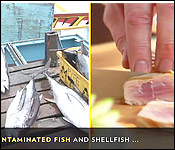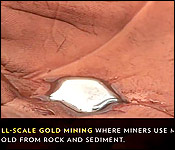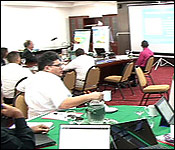

 It is a recommended practice to read the labels and ingredients on food items and other products. Well, one ingredient you should look out for is mercury. We have reported on several health advisories warning consumers to slow it down on eating certain species of fish because of the high mercury level. Well, today the DOE along with its partners held the first session in preparing for the project entitled "Development of Minamata Initial Assessment in the Caribbean -Belize. It's all about minimizing the impact of mercury on humans and the environment. Courtney Weatherburne has more.
It is a recommended practice to read the labels and ingredients on food items and other products. Well, one ingredient you should look out for is mercury. We have reported on several health advisories warning consumers to slow it down on eating certain species of fish because of the high mercury level. Well, today the DOE along with its partners held the first session in preparing for the project entitled "Development of Minamata Initial Assessment in the Caribbean -Belize. It's all about minimizing the impact of mercury on humans and the environment. Courtney Weatherburne has more.
Courtney Weatherburne reporting
This metallic liquid is Mercury also known as quicksilver. It is a chemical element and it can be found in several everyday products such as fluorescent light bulbs and batteries, even in some cosmetic products.
It is also found in some species of fish and if consumed in large amounts over a period of time, it can cause serious health problems.
Tahlia Ali Shah, Project Execution Officer, BCRC
"The thing about Mercury is that it never breaks down after continual exposure. So it's not one time you expose to Mercury you will have negative effects. After continual exposure, you can have anything from different neurological disorders, motor functions, children and women of child bearing age. Mercury, overtime starts to accumulate in water ways and it works up the food chain. In the larger fish species, not all, but in certain fish species especially after continual consumption of years and years of Mercury contaminated fish, it can have effects especially on - if pregnant women consume the fish over a long period of time, their fetus may be expose to different neurological disorders etc."
The Basel Convention Regional Center for the Caribbean along with the Department of the Environment have teamed up to assess the impact of mercury in Belize and to see if Belize can sign on to the Minamata Convention.
 Tahlia Ali Shah, Project Execution Officer, BCRC
Tahlia Ali Shah, Project Execution Officer, BCRC
"So we are here today for the inception workshop for the national Minamata issue assessment in the Caribbean project. Minamata Convention is actually an international environmental agreement that came about to help implement measures to protect the human health and the environment from the negative effects of this chemical Mercury. So today we are doing Minamata initial assessment to try and help Belize decide if they want to become part of the convention or not and what they need to do to do that."
Reporter
"What are some of the specific points you guys are addressing and how you go about testing Mercury and so?"
Tahlia Ali Shah, Project Execution Officer, BCRC
"The project itself is split into 3 different parts. We have first and foremost the legislative and institutional capacity assessment. So that looks at the needs and the gaps etc.,. In the government and what needs to be done to help implement the convention. Also, an inventory aspect. It's more of a desktop study looking at the different sources of Mercury in the country and trying to quantify the data to really decide what are the top 3 main categories for Mercury releases."
 Marco Antonio Manzanilla, National Project Coordinator, DOE
Marco Antonio Manzanilla, National Project Coordinator, DOE
"Several studies have been done in Belize pertaining to Mercury. We've done studies with the Goliath Grouper for example and we've done sampling in the different of Belize. Just in December there was a publication where an advisory was given to the Belizeans of the quantity of certain types of fishes that they could eat. When it comes to the Minamata special assessment we were not a part to the convention, but being a part of this project will tell us if we will be able to be part of that convention."
Belize is the 9th Caribbean country working on this project. The team will carry out field testing and inventory throughout this year. It is a 2 year project.
| 
